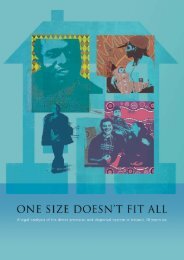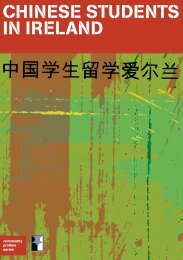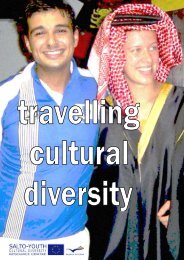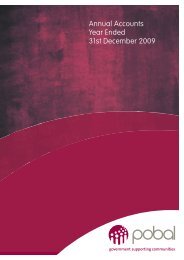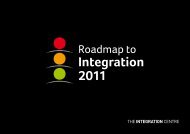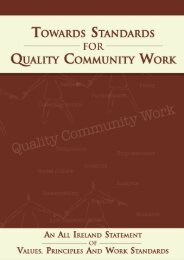Intercultural Education in the Post-Primary School - National Council ...
Intercultural Education in the Post-Primary School - National Council ...
Intercultural Education in the Post-Primary School - National Council ...
You also want an ePaper? Increase the reach of your titles
YUMPU automatically turns print PDFs into web optimized ePapers that Google loves.
INTERCULTURAL EDUCATION ACROSS THE CURRICULUM 5technological experience presents tostudents are similar <strong>in</strong> any cultural contextbut its resolution will be dependent on <strong>the</strong>resources available <strong>in</strong> that community.Explor<strong>in</strong>g ‘design and make’ situationswhere <strong>the</strong> availability of materials andprocesses is restricted to reflect a differentset of cultural circumstance is an approachthat has been used <strong>in</strong> <strong>the</strong>se subjects andhas considerably more potential.These subjects seek to ‘contribute to <strong>the</strong>students appreciation of ecological andenvironmental factors and <strong>the</strong> use ofnatural resources’ (Materials Technology(wood) Syllabus, p.4) and ‘to develop <strong>the</strong>student’s knowledge and understand<strong>in</strong>g ofhow technology impacts on society and anunderstand<strong>in</strong>g of how it might be used to<strong>the</strong> benefit or detriment of <strong>the</strong> social andphysical environment’ (TechnologySyllabus, p.2). The engagement required by<strong>the</strong>se aims leads to an appreciation of <strong>the</strong>often conflict<strong>in</strong>g needs of a variety ofcultures.It is evident that <strong>the</strong>se subjects can providefor <strong>the</strong> encouragement of curiosity aboutcultural differences. They can contribute to<strong>the</strong> acquisition of perspectives by studentson <strong>the</strong>ir own practices and <strong>the</strong>ir impact ono<strong>the</strong>r societies which are all benefits of an<strong>in</strong>tercultural education.In an <strong>in</strong>clusive technology educationexperience• students appreciate <strong>the</strong> orig<strong>in</strong>s of <strong>the</strong>ma<strong>in</strong> materials <strong>the</strong>y work with <strong>in</strong> <strong>the</strong>classroom and <strong>the</strong> impact <strong>the</strong>production of that material has on <strong>the</strong>community <strong>the</strong>y orig<strong>in</strong>ated from• students explore <strong>the</strong> solution <strong>the</strong>y wouldpropose to a design and manufactureproblem, given a different set ofeconomic and cultural constra<strong>in</strong>ts tothose <strong>the</strong>y are familiar with• students will appreciate <strong>the</strong> contributionof o<strong>the</strong>r cultures to <strong>the</strong> advancement oftechnology• students will have an appreciation ofalternative manufactur<strong>in</strong>g techniquesand craft traditions from o<strong>the</strong>r parts of<strong>the</strong> world.2. Technical GraphicsTechnical Graphics develops <strong>the</strong> skills ofstudents <strong>in</strong> represent<strong>in</strong>g <strong>the</strong> physicalworld <strong>in</strong> a graphical format. Thisrepresentation conforms to <strong>in</strong>ternationallyagreed norms which are <strong>in</strong> use worldwideresult<strong>in</strong>g <strong>in</strong> a common graphical ‘language’be<strong>in</strong>g used <strong>in</strong> most cultural contexts.This provides a unique opportunity forteachers to focus on <strong>the</strong> similarity thatexists <strong>in</strong> communication across variouscultures and to utilise graphic images thatorig<strong>in</strong>ate <strong>in</strong> o<strong>the</strong>r cultures as a basis forclassroom activity.In an <strong>in</strong>clusive Technical Graphicsprogramme• students will be presented withopportunities to draw logograms ando<strong>the</strong>r objects that orig<strong>in</strong>ate <strong>in</strong> o<strong>the</strong>rcultures;• students will read product assembly<strong>in</strong>structions presented to <strong>the</strong>m <strong>in</strong> anunfamiliar language with associatedgraphical illustration;• students will be presented with asituation that requires <strong>the</strong>m to generategraphical images that can form <strong>the</strong> basisof communication with people <strong>in</strong> o<strong>the</strong>rparts of <strong>the</strong> world.A detailed audit of <strong>the</strong> opportunities for<strong>in</strong>clud<strong>in</strong>g <strong>in</strong>tercultural <strong>the</strong>mes <strong>in</strong>Technology subjects as well as samplelessons can be found on <strong>the</strong> CD-ROM andat www.ncca.ie.<strong>Intercultural</strong> <strong>Education</strong> <strong>in</strong> <strong>the</strong> <strong>Post</strong>-<strong>Primary</strong> <strong>School</strong> 77








